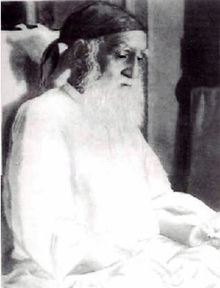Meher Ali Shah facts for kids
Quick facts for kids Pir Meher Ali Shah Golarvi |
|
|---|---|
 |
|
| Religion | Islam |
| Denomination | Sunni |
| Order | Sufism Qadiriya Chishti Order |
| Personal | |
| Born | 14 April 1859 (1 Ramadan 1275 A.H.) Golra Sharif, Punjab, British India (present-day Punjab, Pakistan) |
| Died | May 1937 (aged 78) Golra Sharif, Punjab, British India |
| Children | Ghulam Mohiyyuddin Gilani |
| Parents |
|
| Senior posting | |
| Based in | Golra Sharif |
| Title | Pir, Syed |
| Predecessor | Sial Sharif |
| Successor | Ghulam Mohiyyuddin Gilani |
Pir Syed Meher Ali Shah (born April 14, 1859 – died May 1937) was a very respected Sufi saint, scholar, and poet. He lived in Punjab, which is now part of Pakistan. He belonged to the Chishti Sufi order.
Pir Meher Ali Shah was known for his deep knowledge of Islam. He wrote several books, including his famous work Saif e Chishtiyai. This book shared his strong religious views. He came from a respected family with connections to important figures in Islamic history.
Contents
Early Life and Learning
Pir Meher Ali Shah started his religious education at a young age. He studied at the local religious schools, called Khanqah and Madressah. There, he learned Urdu and Persian.
When he was 15, he decided to study even more. He traveled to different cities in India. These cities, like Lucknow and Delhi, were famous for their religious schools. He spent two and a half years studying in Aligarh.
Important Writings
Pir Meher Ali Shah wrote many books. These books shared his thoughts on Islamic teachings. His most famous book was Saif-e-Chishtiya.
Here are some of his other important works:
- Tahqiq-ul-Haq Fi Kalima-tul-Haq (The Truth about Kalima-tul-Haq)
- Shamsul Hidayah
- I’la Kalimatillah Fi Bayan-e-Wa Ma Uhilla Bihi Legharillah
- AlFatuhat-us-Samadiyyah (Divine Bounties)
- Tasfiah Mabain Sunni Wa Shi’ah
- Fatawa-e-Mehria
- Mulfuzaat-e-Mehria (Sayings of Meher Ali Shah)
- Books explaining his religious views
His Religious Views
Pir Meher Ali Shah was a student and spiritual successor (called a khalifa) of Khawaja Shams-ud-din Sialvi. He followed the Chishtia Nizamiyah Sufi path. He also became a khalifa under Hajji Imdadullah in Mecca.
He supported the idea of Wahdat-ul-Wujood, which means "Unity of Being." This idea suggests that everything in the universe is connected to God. However, he also taught that there is a clear difference between God and His creation.
Pir Meher Ali Shah was an expert on the writings of Ibn Arabi. Ibn Arabi was a famous Islamic scholar. In 1933, a well-known philosopher named Muhammad Iqbal wanted to learn more about Ibn Arabi's ideas. He wrote a letter to Pir Meher Ali Shah asking for his help. However, Pir Meher Ali Shah was unwell and deep in meditation, so he could not reply.
Building a Historic Mosque
In the old city of Rawalpindi, a beautiful Mughal-style mosque was built. It was called the Central Jamia Masjid. This mosque was completed in 1903. It was built with donations from the Muslim community in the area.
Pir Meher Ali Shah helped open this mosque. The king of Afghanistan, Ayub Khan, who was living in Rawalpindi at the time, also attended the opening. Many important Muslim leaders later led prayers at this mosque.
Passing Away
In April 1937, Pir Meher Ali Shah became ill with typhoid fever. His health got worse over several days. On May 11, 1937, he passed away. His last words were "Allah" (God).
Every year, a three-day event called Urs is held to remember him. It takes place from the 27th to the 29th of Safar (an Islamic month). Thousands of people from all over Pakistan visit his tomb during this time. They come to honor this great Sufi saint and poet.
Honors and Legacy
Pir Meher Ali Shah is remembered in several ways:
- Pakistan Post released a special postage stamp in 2013 to honor him.
- A university in Rawalpindi is named after him: Pir Mehr Ali Shah Arid Agriculture University.
Images for kids
-
Printed copy of Iqbal's letter.
See also
- Naseer-uddin-Naseer





